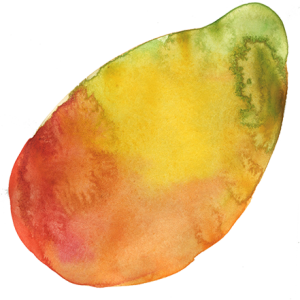Award Winning Author
Face Reading with Before & After Photos
Prevent Macular Degeneration with Diet
Here’s how to use a wide variety of brightly colored vegetables to keep your vision healthy. Macular degeneration—a leading cause of blindness—is preventable. Helping prevent macular degeneration (MD) is as near at hand as corn and collards. Lutein and zeaxanthin (ze.a.xan.thin), the two carotenoid pigments that color yellow and green produce, are the responsible antioxidants. When you eat ample colorful veggies and fruit, you protect your eye sight.
Of course, an overall healthy diet and lifestyle supports healthy vision. But lutein and zeaxanthin appear to be the most potent nutrients to prevent MD. This degenerative eye disease is the leading cause of legal blindness in people over the age of 55.
That’s why people are advised to eat more produce. What to do, however, if you cherish your vision but don’t like collards and tire of corn? The good news is there are dozens of antioxidant-rich vegetables and fruits.
So do your eyes a favor and the next time you’re at the market, go for color. Look afresh at the produce section and bring home something orange and a couple of leafy strangers. Should your market have only a paltry selection of bright veggies, find a better market.
Let’s look at the sources for both lutein and zeaxanthin. The latter is highest in yellow corn, yellow and orange peppers, winter squash, carrots, yams, cantaloupe, peaches, grapes, oranges, mangos and nectarines. My rule of thumb is to daily enjoy a serving of a yellow vegetable and, in season, a yellow fruit.
Because lutein is most abundant in greens, here’s a map for identifying—and using—the lutein rich greens. Aim for a minimum of three green servings daily.
The darker the green, the higher the lutein. So which veggie part is the green gold-mine? It’s the leaf. Curiously enough only four botanical families provide over 95% of the leafy greens in our markets.
Because the vegetables in each group share culinary properties all you need to know is how to use one from each family and then you can freely substitute others. This expands your green repertoire exponentially.
And, here’s the good news. You can already fix lettuce, spinach, parsley and broccoli and they each represent one of the four leafy groups.
Four Types of Leafy Greens
1. Lettuce Family Have you met lettuce’s relations? Dandelions, endive, frissee and the various types of chicory are all great in salads. If they’re exceptionally bitter, add them sparingly to a salad or parboil and serve them like spinach. Braising, which means simply to sauté until wilted, also works for lettuce and its clan.
2. Spinach Family The next vegetable group high in lutein includes spinach and relatives. When tender, spinach and beet greens are tasty in salad. They, along with chard and the lesser known relatives amaranth and orach, are also used as potherbs (boiled in water), added to soups and casseroles or sautéed. Unlike spinach, it’s useful to separate chard leaves from their stems and to prepare leaves and stems as two separate vegetables.
3. Parsley & Relatives Third is parsley and its cousins—celery, cilantro, dill and fennel. Remember that a parsley garnish and celery leaves are edible and munch on them accordingly. I lavish parsley and other green herbs in soup, omelets and just about everything but dessert.
4. Cabbage Family Last we have the cabbage family. In terms of dark leaves and versatility, this clan which includes broccoli, reigns supreme. So, if your soup, stir-fry or casserole calls for broccoli, try substituting it with one of its hardy relatives such as bok choy, Brussels sprouts, cabbage, collards, mustard greens or kale.
The more delicate greens of the cabbage family, arugula, Chinese cabbage, mizuna and watercress, are excellent in a salad or lightly cooked dishes. If any of these veggies is a foreigner to your kitchen you and don’t know if it’s hardy or delicate…nibble a leaf and you’ll know. The more tender and/or delicately-flavored greens require little or no cooking; whereas, the more bitter, pungent and/or tough greens require more cooking. Sautéing moderates the strong flavor of mustards and kale.
Also, lutein is in more than just vegetable leaves. Some edible stalks contain it, like asparagus, celery and fennel. It’s in some edible flowers like broccoli and artichokes. Lutein is found in vegetable fruits like peas, green beans and avocados; it colors some edible skins, like cucumbers, zucchini and acorn squash. So don’t peel cucumbers and when the squash skin is toothsome, bon appetit.
May you be well nourished,
Rebecca Wood


Is there any connection between taking a statin drug and being diagnosed with macular degeneration and cateracts?
Eye diseases can be prevented through food supplements and also making sure that your eye gets a good rest after eye intensive tasks like working on a computer for long periods of time. “*`:
So, if I’m sure I’m beginning to have Macular Degeneration (and no, my diet has not been ideal)….will the diet help me in the future?
I’m sorry; that’s sobering news. Yes of course, upgrading your diet will decidedly help slow the advance. Favor foods that build your overall energy. As vision is a function of your liver system, make sure your diet is liver-friendly. There’s a lot more you can in addition to enjoying foods high in lutein and zeaxanthin. I’d be glad to help you with your diet in a consultation or you’ll find supportive information in my books. Good luck!